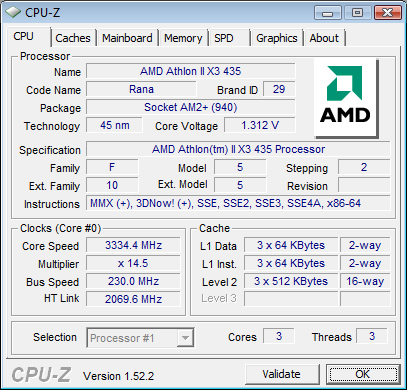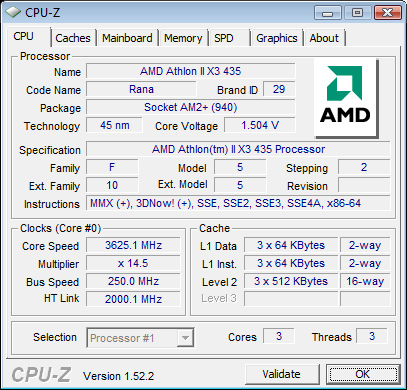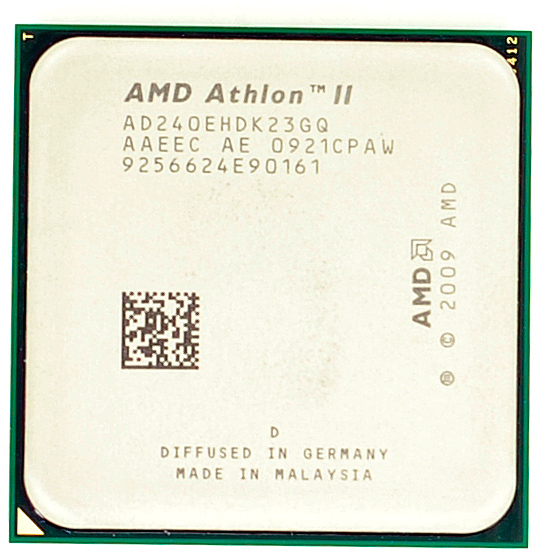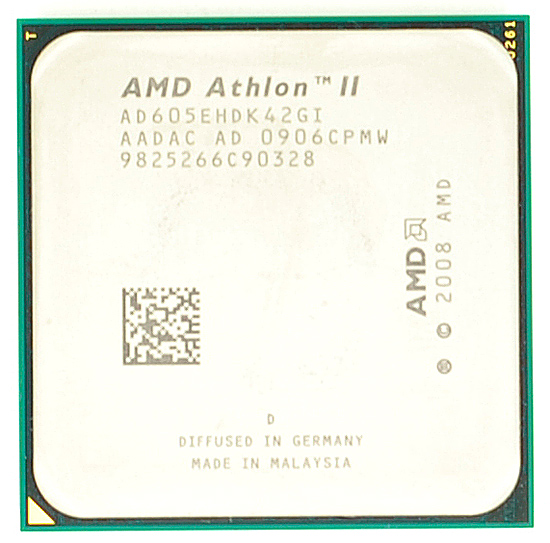AMD's Athlon II X3 435 & New Energy Efficient CPUs: Killing Intel Below $90
by Anand Lal Shimpi on October 20, 2009 12:00 AM EST- Posted in
- CPUs
A month ago AMD introduced the world’s first quad-core processor to debut at $99. Last week, AMD announced its third quarter earnings for 2009. While the company as a whole lost money, the Product Company (CPU and GPU design) turned a small profit. I don’t want to say that the worst is behind AMD, but things are definitely looking up.
| Income | Q3 2009 | Q2 2009 | Q1 2009 |
| AMD | -$128 Million | -$330 Million | -$416 Million |
| AMD Product Company | +$2 Million | -$244 Million | -$308 Million |
And for the consumer, AMD is providing a ton of value these days. You're getting more transistors per dollar than Intel will give you, and it's not just bloat, these things are fast:
| Processor | Cores | Manufacturing Process | L1 Cache | L2 Cache | L3 Cache | Die Size | Transistor Count |
| AMD Phenom II X4 | 4 | 45nm | 128KB per core | 512KB per core | 6MB | 258 mm2 | 758M |
| AMD Athlon II X4/X3 | 4 | 45nm | 128KB per core | 512KB per core | 0MB | 169 mm2 | 300M |
| AMD Athlon II X2 | 2 | 45nm | 128KB per core | 1MB per core | 0MB | 117 mm2 | 234M |
| Intel Core 2 Quad Q8xxx | 4 | 45nm | 64KB per core | 4MB | 0MB | 164 mm2 | 456M |
| Intel Pentium E6xxx | 2 | 45nm | 64KB per core | 2MB | 0MB | 82 mm2 | 228M |
The value train continues with todays introduction of the first triple core Athlon II processors: the Athlon II X3 435 and 425. Clocked at 2.9GHz and 2.7GHz respectively, these processors are simply Athlon II X4s with one core disabled.

They’re also quite affordable. The 435 will set you back $87 while the 425 costs $76. This puts them on par with Intel’s Pentium E6000 series dual core processors, but cheaper than the Core 2 Duo E7500. This has been AMD’s high end dual core strategy for the Phenom’s life: sell three cores for the price of two. And in the past, it has worked.
| Processor | Clock Speed | L2 Cache | L3 Cache | TDP | Price |
| AMD Phenom II X4 965 BE | 3.4GHz | 2MB | 6MB | 140W | $245 |
| AMD Phenom II X4 955 BE | 3.2GHz | 2MB | 6MB | 125W | $245 |
| AMD Phenom II X4 945 | 3.0GHz | 2MB | 6MB | 125W | $225 |
| AMD Phenom II X3 720 BE | 2.8GHz | 1.5MB | 6MB | 95W | $145 |
| AMD Phenom II X2 550 BE | 3.1GHz | 1MB | 6MB | 80W | $105 |
| AMD Athlon II X4 630 | 2.8GHz | 2MB | 0MB | 95W | $122 |
| AMD Athlon II X4 620 | 2.6GHz | 2MB | 0MB | 95W | $99 |
| AMD Athlon II X3 435 | 2.9GHz | 1.5MB | 0MB | 95W | $87 |
| AMD Athlon II X3 425 | 2.7GHz | 1.5MB | 0MB | 95W | $76 |
| AMD Athlon II X2 250 | 3.0GHz | 2MB | 0MB | 65W | $87 |
| AMD Athlon II X2 245 | 2.9GHz | 2MB | 0MB | 65W | $66 |
| AMD Athlon II X2 240 | 2.8GHz | 2MB | 0MB | 65W | $60 |
The X3s AMD is announcing today are clocked high enough that you still have good performance in single threaded applications, and in those that can take advantage of three cores you’re almost guaranteed to have better performance than the Intel alternative.
The real question you have to ask is whether it makes more sense to spend a little more than get a quad-core processor or not.
The Athlon II X3s are 45nm 95W TDP parts and work in both Socket-AM2+ and Socket-AM3 motherboards. As I mentioned before, these are architecturally identical to the X4s just with one core disabled. That means you get a 512KB L2 per core but no L3 cache.
I’ll spoil the surprise for you here: they’re faster than the equivalently priced Intel CPUs in most cases, but that’s not too surprising.
The Athlon II X3 435 is a bit more overclockable than the X4 620. Without any additional voltage we got 3.25GHz on our 620 sample, but our 435 yielded 3.33GHz:

With an extra ~15% voltage we could get 3.63GHz:

AMD is also introducing a slew of energy efficient Athlon IIs as well. They’re all in the table below:
| Processor | Clock Speed | L2 Cache | TDP | Price | Premium |
| AMD Athlon II X4 605e | 2.3GHz | 2MB | 45W | $143 | +$44 |
| AMD Athlon II X4 600e | 2.2GHz | 2MB | 45W | $133 | +$34 |
| AMD Athlon II X3 405e | 2.3GHz | 1.5MB | 45W | $102 | +$26 |
| AMD Athlon II X3 400e | 2.2GHz | 1.5MB | 45W | $97 | +$21 |
| AMD Athlon II X2 240e | 2.8GHz | 2MB | 45W | $77 | +$17 |
| AMD Athlon II X2 235e | 2.7GHz | 2MB | 45W | $69 | +$9 |
These energy efficient processors are binned for lower voltages and thus have a 45W TDP. Unfortunately you do sacrifice clock speed in some cases as a result. There's also a hefty price premium, at the high end you lose clock speed and pay 44% more for a 45W TDP.


The Test
| Motherboard: | Intel DX58SO (Intel X58) Intel DX48BT2 (Intel X48) Gigabyte GA-MA790FX-UD5P (AMD 790FX) |
| Chipset: | Intel X48 Intel X58 AMD 790FX |
| Chipset Drivers: | Intel 9.1.1.1015 (Intel) AMD Catalyst 8.12 |
| Hard Disk: | Intel X25-M SSD (80GB) |
| Memory: | Qimonda DDR3-1066 4 x 1GB (7-7-7-20) Corsair DDR3-1333 4 x 1GB (7-7-7-20) Patriot Viper DDR3-1333 2 x 2GB (7-7-7-20) |
| Video Card: | eVGA GeForce GTX 280 |
| Video Drivers: | NVIDIA ForceWare 180.43 (Vista64) NVIDIA ForceWare 178.24 (Vista32) |
| Desktop Resolution: | 1920 x 1200 |
| OS: | Windows Vista Ultimate 32-bit (for SYSMark) Windows Vista Ultimate 64-bit |










177 Comments
View All Comments
maddoctor - Tuesday, October 20, 2009 - link
Currently, Intel does not need any competitor. Intel will crush them as soon as possible with prices cutting. This is their own fault, why they are not so competitive in performance and can not wins the benchmarkfsdetained - Wednesday, October 21, 2009 - link
Because they've done this so well with AMD for the last 20+ years... great logic little boy...santiago321 - Tuesday, October 20, 2009 - link
I am sure this joker has no idea about computers. If only designing GPU chips and killing competition was so simple.Tell you what, consider these two facts;
1. Intel has been trying to kill AMD for last 40 years and still trying
2. It took intel 5 years to add Northbridge in the die after amd did that in 2004.
Tech forums are no paradise for jokers. Go home and sleep well
coldpower27 - Friday, October 30, 2009 - link
1. Intel isn't trying to kill AMD, they are trying to shackle AMD into the budget range and keep them there, AMD sole purpose is to remain as a second supplier and to give the appearance of competition, so for Intel AMD serves a purpose.2. Intel didn't care about having a memory controller on their processors as they were already outperforming AMD's offerings without it. It isn't the be all and end all to performance and also comes with disadvantages as well. Core 2 outperformed Athlon 64's of the time, and were even to equivalently clocked 45nm Phenoms, 65nm AMD had it's own share of issues.
maddoctor - Tuesday, October 20, 2009 - link
What Intel never trying to kill AMD. This is only AMDiot assumption. Ask Anand, he will never agree with you AMDiot. This is the nature of capitalism. Money and product competitiveness are the facts that you can not denied.fsdetained - Wednesday, October 21, 2009 - link
Shitty pun, knock it off. Intel has tried to crush AMD since 1986. Where have you been? Oh, right, you probably weren't even born when the 8080 and 8086 processors came out for the IBM PC or even when the AM286 came out.Money, product, and competitiveness are not facts they are words you just threw out to sound like you know something. You have no clue about business, go back to your 6th grade classes.
yuhong - Tuesday, October 20, 2009 - link
"2. It took intel 5 years to add Northbridge in the die after amd did that in 2004. "Do you mean memory controller? But, BTW, Transmeta was able to put northbridge into the die back in 1999.
AnnihilatorX - Tuesday, October 20, 2009 - link
My sacarsm meter dial has turned through 3 circles and landed the negative spot.StevoLincolnite - Tuesday, October 20, 2009 - link
There is so much wrong with your post it's not funny, but I'll point some out.1) We have no idea how Larrabee will perform.
2) nVidia ATI/AMD are not going anywhere soon.
3) Intel got beaten by ATI and nVidia in the Graphics card market before when Intel released the Intel i740i AGP graphics card.
4) With Intels history of poor driver support for there Graphics solutions, I don't have much faith in Larrabee being different, I hope I'm wrong though, the added competition would be awesome.
5) If Intel owns the Chipset/CPU/Graphics markets 100% that would be -bad- no competition to keep prices low, remember when a decent computer would cost over 3 thousand bucks?
6) Both ATI and nVidia have had YEARS of experience in the Graphics industry, they will not let a new player into that market without a fight.
7) I would -not- be happy if we lost any extra company's especially AMD and nVidia, it would be all-round bad for everyone, I wouldn't have been able to build a stupidly cheap Quad-Core system (Athlon 2 x4 620) if it weren't for AMD.
pinguin - Tuesday, October 20, 2009 - link
>>remember when a decent computer would cost over 3 thousand bucks?I wouldn't mind paying $3000 for a decent computer, but please remember that even an undecent one would have set you back $1500 back then, while nowadays you can buy a $500 AMD rig